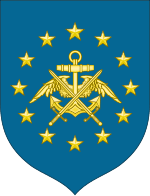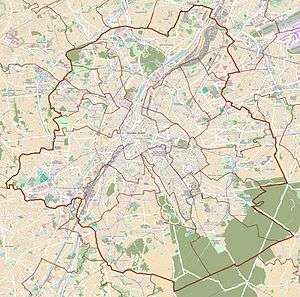European Union Military Staff
| European Union Military Staff | |
|---|---|
 Coat of arms | |
| Active | 2004–present |
| Allegiance |
|
| Type | Military staff |
| Role | Supervises CSDP operations, provides strategic advice to the High Representative, reports to the EUMC. |
| Size | 200+ personnel |
| Part of | European External Action Service |
| Location | Avenue de Cortenbergh 150, Brussels, Belgium |
| Website | europa.eu |
| Commanders | |
| High Repr. | Federica Mogherini |
| Director General | Lieutenant General Esa Pulkkinen |
| Deputy Director General | Major General Giovanni Manione |
The Military Staff of the European Union (EUMS) is the directorate-general of the European Union's (EU) External Action Service (EEAS) that contributes to the EU's Common Security and Defence Policy (CSDP) by providing strategic advice to the High Representative (HR/VP) and commanding non-combat operations through its Military Planning and Conduct Capability (MPCC) operational headquarters. EU officials have indicated that a review in 2018 might extend the MPCC's mandate to also include operations with combat elements.[1][2]
The EUMS also reports to the European Union Military Committee (EUMC), representing member states' Chiefs of Defence, and performs "early warning", situation assessment and strategic planning.
The EUMS currently consists of 200+ military and civilian personnel, and is located in the Kortenberg building in Brussels.
History

1993–2000: Background
The Common Foreign and Security Policy (CFSP) was introduced as a pillar of the EU by the Treaty of Maastricht in 1993, based on the earlier 1970 European Political Cooperation (EPC). The CFSP was to include ‘all questions related to the security of the Union, including the eventual framing of a common defence policy, which might in time lead to a common defence’.
In December 1998 the Franco-British Saint-Malo declaration stated that the EU ‘must have the capacity for autonomous action, backed up by credible military forces, the means to decide to use them, and a readiness to do so, in order to respond to international crises’. This marked a British change of course, as it previously had blocked any development of EU autonomous military capabilities.
At the European Council in Cologne in June 1999 the European Security and Defence Identity (ESDI) - formed in 1996 as a project between Western European Union's (WEU) and the North Atlantic Treaty Organisation (NATO) - was transfererred to the EU and renamed the European Security and Defence Policy (ESDP). The main goal of this newly established CSDP was to deal with crisis management outside EU territory.
2001: Creation as a Council body
In 2000 and 2001 a number of Council bodies were established as part of the ESDP:
- Political and Security Committee (PSC), a preparatory body of ambassadorial level representatives thar observes the international situation, helps to define CFSP and ESDP policies and prepares a coherent EU response to a crisis
- EU Military Committee (EUMC), the Council's highest military body, composed of member states' Chiefs of Defence, who are regularly represented by their permanent military representatives. The EUMC provides the PSC with advice and recommendations on all military matters within the EU.
- European Union Military Staff (EUMS), a part of the General Secretariat whose primary task was to by EUMC's working and advisory body
In 2003 the Treaty of Nice provided the ESDP's legal foundation, in terms of competences, organisation, structures and assets.
2009: Transfer to the External Action Service
Upon the entry into force of the Treaty of Lisbon in 2009 the EUMS was transferred from the Council's General Secretariat to become a Directorate-General (DG) of the newly established European External Action Service (EEAS) - the EU's diplomatic service, a hybrid Council-Commission body resulting from a merger of the external relations departments of the Council and relevant international relations departments of the European Commission.
2016: Addition of the MPCC
In 2016 European Union Global Strategy was presented by HR Federica Mogherini and welcomed by the European Council. The implementation of this strategy in the field of CSDP has included the establishment of the Military Planning and Conduct Capability (MPCC), which gives the EUMS the role of commanding operations directly.
Task
The EUMS performs a supervisory function in relation to Common Security and Defence Policy (CSDP) operations:
- providing strategic advice to the High Representative
- reporting to the European Union Military Committee (EUMC)
- performing "early warning, situation assessment and strategic planning for Petersberg tasks" and to implement CSDP missions (2001/80/CFSP, annex article 2) such as EUFOR Althea and the other European Union Force missions in Chad/CAR and the DR Congo.
The EUMS has supervised a number of deployments since its establishment.
Structure
The CSDP command structure involving the High Representative, the Military Staff and Military Committee as of 1 November 2017:[3]
Colour key:
High Representative (a Vice-President of the Commission)
![]()
![]()
| High Representative | |||||||||||||||||||||||||||||||||||||||||||||||||||||||||||||||||
 Military Committee Chairman | |||||||||||||||||||||||||||||||||||||||||||||||||||||||||||||||||
| Working Group | |||||||||||||||||||||||||||||||||||||||||||||||||||||||||||||||||
 Working Group/Headline Goal Task Force | Military Staff Director General | ||||||||||||||||||||||||||||||||||||||||||||||||||||||||||||||||
| Legal advisor | Deputy Director General | Horizontal Coordination | |||||||||||||||||||||||||||||||||||||||||||||||||||||||||||||||
| Assistant Chief of Staff for Synchronisation | EU cell at SHAPE | EU Liaison at the UN in NY | Assistant Chief of Staff for External Relations | NATO Permanent Liaison Team | |||||||||||||||||||||||||||||||||||||||||||||||||||||||||||||
| Directorate A: Concepts & Capabilities | Directorate B: Intelligence | Directorate C: Operations | Directorate D: Logistics | Directorate E: Communications & Information Systems | Military Planning and Conduct Capability
| ||||||||||||||||||||||||||||||||||||||||||||||||||||||||||||
The EUMS is a Directorate-General of the External Action Service (EADS) that is located in the Kortenberg building in Brussels and currently consists of 200+ military and civilian personnel.
Director General
._Arrivals_Esa_Pulkkinen_(36890876876)_(cropped).jpg)
The EUMS is led by the Director General (DGEUMS, a three-star general).[4]
Since 2017 DGEUMS has also served as Director of the Military Planning and Conduct Capability, and as such assumes the function of the single commander for all non-executive military missions, exercising command and control over the current three training Missions and other possible future non-executive military Missions.
DGEUMS is assisted by the Deputy Director General and the Chef of Staff (DDG/COS, a two-star general).[5]
Military Planning and Conduct Capability
The Military Planning and Conduct Capability (MPCC) is an EUMS facility that provides a permanent operational headquarters at the military strategic level for non-executive military missions. The MPCC will be reporting to the Political and Security Committee (PSC), and informing the European Union Military Committee (EUMC).[6]
The MPCC will at present control the three EU training missions in Central African Republic, Mali and Somalia.
The MPCC will cooperate with its existing civilian counterpart, the Civilian Planning and Conduct Capability (CPCC), through a Joint Support Coordination Cell (JSCC).
EU officials have indicated that a review in 2018 might extend the MPCC's mandate to also include operations with combat elements - or so-called executive missions.[7] Such a development could establish the MPCC as a single EU military operational headquarters (OHQ), replacing the previous practice in which the EUMS has not controlled EU military missions directly, and where the Council has determined a dedicated ad hoc OHQ for each operation, typically out of one of the following categories:
- National 'parent headquarters', e.g. Northwood Headquarters as made available by the United Kingdom
- Allied Command Operations (ACO) of the North Atlantic Treaty Organisation (NATO), based on the Berlin Plus agreement
- European Union Operations Centre (EU OPCEN), a limited ad hoc headquarters outside the EEAS
Directorates
The EUMS has five directorates, each led by a one-star commander.[8]
Concepts and Capabilities
The Concepts and Capabilities Directorate (CON/CAP) is responsible for EUMS concepts, doctrine and the planning and development of capabilities including crisis management exercises, training, analysis and lessons learned, and for cooperation with the European Defence Agency (EDA), ensuring coherency between the EU military concepts and the crisis management procedures.[9]
Intelligence
The Intelligence Directorate (INT) has the following tasks:[10]
- To provide intelligence input to early warning and situation assessment
- To contribute to the EUMS planning through the provision of intelligence and intelligence planning expertise
- To provide the intelligence input to crisis response planning and assessment for operations and exercises.
Operations
The Operations Directorate (OPS) has the following tasks:[11]
- To plan military crisis management operations, including post-launch strategic crisis response planning
- To develop strategic advance and crisis response planning, including early military assessment and planning in support of informed decision making
- To monitor all CSDP operations and to generate the capacity to plan and run an autonomous operation.
Logistics
The Logistics Directorate (LOG) provides administrative support, logistic planning expertise, logistic concepts, doctrine related to crisis response planning. LOG also assesses operations and exercises.[12]
Communication and Information Systems
The Communication and Information Systems Directorate (CIS) is has the following tasks:[13]
- To develop the EUMS' policies and guidance for implementation, operation and maintenance of communication and information systems, in support of CSDP activities.
- To contribute to EUMS planning through the provision of CIS planning expertise at the strategic and operational level
- To provide the CIS element of crisis response planning and assessment for operations and exercises.
Other units
Other units at the EUMS include:[14]
- ACOS Synchronisation unit, which assists the Chief of Staff in the coordination and synchronization of the EUMS internal processes and information flows, to facilitate and canalise the support the EUMS provides to the Chairman of the EUMC, and to support him in the preparation and management of meetings.
- ACOS external relations unit, which develops policy for, and maintain the military dimension of, all EUMS' external relations in close cooperation with EEAS Management Directorates and the CMPD. This involves coordinating military-to-military cooperation with International Organisations, Strategic Partners; and Third States. The office is also responsible for all Public Information/Press Relations issues in close collaboration with the EEAS Strategic Communications Division.
- EU cell at SHAPE (EUCS), a unit that prepares for EU operations having recourse to NATO common assets and capabilities under Berlin plus arrangements and to support DSACEUR in his role as a potential operational commander for an EU-led operation. It contributes to full transparency between NATO and the EU embodying their strategic partnership in crisis management.
See also
References
- ↑ https://euobserver.com/foreign/137127
- ↑ http://www.consilium.europa.eu/en/press/press-releases/2017/06/08/military-mpcc-planning-conduct-capability/
- ↑ https://eeas.europa.eu/sites/eeas/files/impetus_24_dp_final_1.pdf
- ↑ http://www.council-tvnewsroom.eu/video/eums-change-of-command-extract
- ↑ http://www.council-tvnewsroom.eu/video/eums-change-of-command-extract
- ↑ http://www.consilium.europa.eu/en/press/press-releases/2017/06/08/military-mpcc-planning-conduct-capability/
- ↑ https://euobserver.com/foreign/137127
- ↑ http://www.council-tvnewsroom.eu/video/eums-change-of-command-extract
- ↑ https://eeas.europa.eu/topics/common-security-and-defence-policy-csdp/5436_en
- ↑ https://eeas.europa.eu/topics/common-security-and-defence-policy-csdp/5436_en
- ↑ https://eeas.europa.eu/topics/common-security-and-defence-policy-csdp/5436_en
- ↑ https://eeas.europa.eu/topics/common-security-and-defence-policy-csdp/5436_en
- ↑ https://eeas.europa.eu/topics/common-security-and-defence-policy-csdp/5436_en
- ↑ https://eeas.europa.eu/topics/common-security-and-defence-policy-csdp/5436_en
External links
| Wikimedia Commons has media related to European Union Military Staff. |